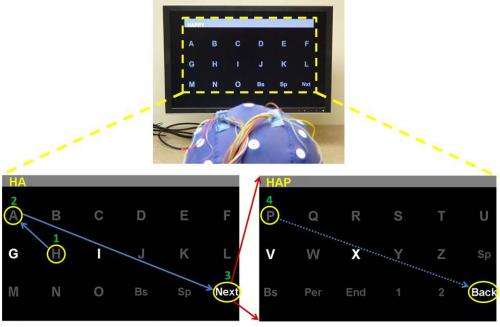Technology helps 'locked-in' stroke patient communicate

People who've had severe strokes and have a condition called "locked-in" syndrome may benefit from a new technology that allows them to communicate with the outside world, according to new research.
The new study reports on a male stroke patient with locked-in syndrome who was paralyzed and could not communicate. With the new "brain-computer interface" he was able to spell out messages to hospital staff and his family, and even respond to questions.
There are caveats. This technology is expensive—about $10,000 a unit. Plus, it will be costly to train medical workers and family members to use it with a patient.
Still, the man's experiences show that the technology "can be a viable communication option when all other methods have failed, and it can also improve quality of life," said report lead author Eric Sellers, director of the Brain-Computer Interface Laboratory at East Tennessee State University. "It was clear that the family also benefited from the patient's ability to use the brain-computer interface."
It's not known how many people suffer from locked-in syndrome in the United States, but the number may be in the tens of thousands, Sellers said. Causes include stroke and traumatic brain injuries, such as those from an accident.
It's "a condition in which a person has become completely paralyzed except for eye movement. Communication is very difficult for these patients, and to do so requires someone to interpret their eye movements," Sellers said.
Some people may have the condition without anyone else realizing it. "It can take weeks or months to diagnose," Sellers said, "and can also be misdiagnosed as vegetative state or minimally conscious state."
Technology has been used previously to allow locked-in patients with Lou Gehrig's disease—amyotrophic lateral sclerosis, or ALS—to communicate by using eye movements, according to background information in the study. Sellers and colleagues wanted to know if it would also work in a stroke patient. They chose a 68-year-old man who'd had a severe stroke six months prior. He lived in a nursing home and couldn't control blinking, making communication impossible outside of some eye movements and head nods.
The technology uses a brain-wave-detecting EEG system to detect the "a-ha" moment when the man found a letter on a computer screen that he wanted to use. He could then create words, although the process was slow: It would take him about 45 minutes to create a whole message, according to the study.
"His first questions were related to his prognosis. After that, he was mostly interested in issues that anyone in a hospital would be interested in," Sellers said. "For example, he told his wife, 'thank you for all of your hard work,' and 'buy yourself a present.' He was also interested in what his children were doing and how they were."
Waleed Meleis, an associate professor of electrical and computer engineering at Northeastern University in Boston, praised the study and said the patient's messages are impressively complex. But he cautioned that the technology is expensive, and "it's very difficult to get insurance to pay for such expensive devices."
The study authors want to make the technology faster and easier to use. But the expense will keep it out of reach of many people, Sellers said.
"We could use off-the-shelf products and build one for about $5,000, which is still too expensive to be a realistic option for most people," he said. "In addition, there are some overhead costs such as monitoring and calibrating the system. Some of this work can be done remotely and some of it requires a visit to the patient's home. It is also necessary for a family member or caregiver to be trained to place the electrode cap, put gel on the electrodes, and operate the software."
Still, "we think that anyone with locked-in syndrome could potentially benefit," Sellers said. The system could also determine if patients thought to have no ability to communicate can actually do so, although Sellers cautioned that it can't prove that someone is not able to communicate. The system may simply not work for some people who might still be able to communicate in a different way.
The study appears in the Oct. 8 issue of Science Translational Medicine.
More information: "Noninvasive brain-computer interface enables communication after brainstem stroke," by E.W. Sellers et al. stm.sciencemag.org/lookup/doi/ … scitranslmed.3007801
Copyright © 2014 HealthDay. All rights reserved.
















